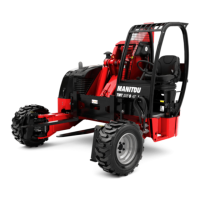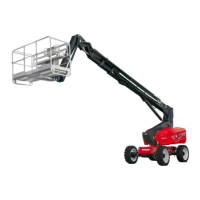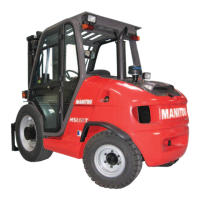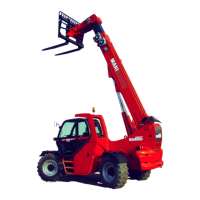1 - 15
INSTRUCTIONS
- Always move the machine with the forks or attachment in the transport position, i.e. approximately
300mm from the ground:
• LADEN, DRIVE WITH THE BOOM RETRACTED AND THE CARRIAGE TILTED BACK.
• UNLADEN, THE BOOM MUST BE FULLY TELESCOPED.
- Select the steering mode appropriate for the use and/or working conditions (
DESCRIPTION:
INSTRUMENTS AND CONTROLS)
(depending on machine model)
.
- Release the parking brake.
- Shift the forward/reverse selector to the selected direction of travel and accelerate gradually until the machine moves off.
G - STOPPING THE MACHINE
SAFETY INSTRUCTIONS
- Never leave the ignition key in the machine during the operator's absence.
- When the machine is stationary, or if the operator has to leave his cab (even for a moment), place the forks or attachment
on the ground, apply the parking brake and place the forward/reverse selector in neutral.
- Make sure that the machine is not stopped in any position that will interfere with the traffic flow and at less than one
meter from the track of a railway.
- In the event of prolonged parking on a site, protect the machine from bad weather, particularly from frost (check the
level of antifreeze), and close and lock all the machine accesses (doors, windows, cowls, etc.).
INSTRUCTIONS
- Park the machine on flat ground or on an incline lower than 15%.
- Set the forward/reverse selector to neutral.
- Apply the parking brake.
- Lower the forks or attachment to rest on the ground, with the boom slightly telescoped.
- When using an attachment with a grab or jaws, or a bucket with hydraulic opening, close the attachment fully.
- Before stopping the machine after intensive work, leave the engine idling for a few moments to allow the coolant and oil
to lower the temperature of the engine and transmission. Do not forget this precaution, in the event of frequent stops
or warm stalling of the engine, or else the temperature of certain parts will rise significantly due to the stopping of the
cooling system, with the risk of badly damaging such parts.
- Stop the engine with the ignition switch.
- Remove the ignition key.
- Lock all the accesses to the machine (doors, windows, cowls, etc.).
H - DRIVING THE MACHINE ON THE PUBLIC HIGHWAY
(or see current legislation in other countries)
FRENCH ROAD TRAFFIC RULES
- The driving of non "EC tractor" type-approved machines on the public highway is subject to the provisions of the Highway
Code relating to special machines, defined in Article R311-1 of the Highway Code, in category B of the Equipment Order
of 20 November 1969 that determines the procedures applicable to special machines. The machine must be fitted with
an operating license plate.
- The driving of "EC tractor" type-approved machines on the public highway is subject to the provisions of the highway
code regarding agricultural tractors, defined in Article R311-1 of the highway code. The machine must be licensed.
SPECIAL INSTRUCTIONS APPLICABLE TO "EC TRACTOR" TYPE-APPROVED MACHINES
• The machine must be driven on the public highway in accordance with the instructions given in the manual supplied
with the machine (Gross weight, Gross combination weight, towing load, axle loads, maximum speeds, etc. according
to the type/version). The operator must be in possession of the machine’s registration document.
• The operator must hold an HGV license, unless granted an exemption.
• When towing a trailer or agricultural equipment, the travel speed of the machine is limited to 25km/h. In this case,
a "25" disc must be affixed to the rear of the convoy. When driving with a trailer, the fact of not engaging 4
th
gear
will ensure compliance with the towing speed limit (max. 25 km/h). On "POWERSHIFT" models, as 3rd gear is slower
than on other models, it is preferable to use 5th gear and disable automatic upshifting to 6th gear ( DESCRIPTION:
INSTRUMENTS AND CONTROLS).
574317
647866 M1 (A012021)
TMT ... K ST5 S1

